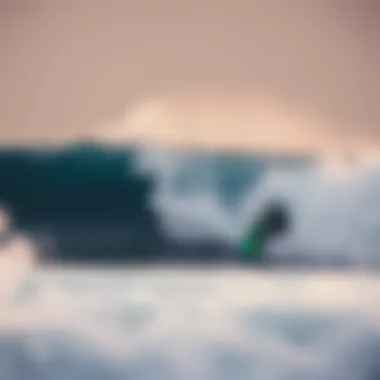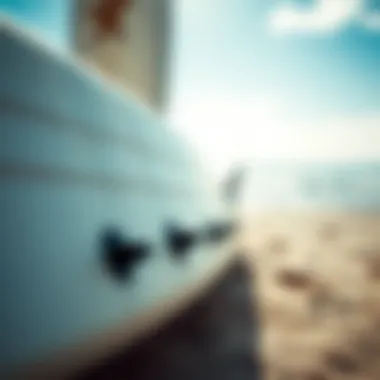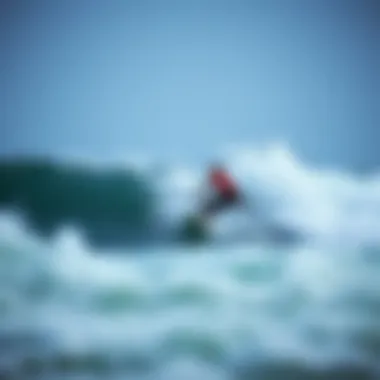Discovering the Best Surfing Destinations Worldwide


Intro
Surfing has long transcended its roots as merely a recreational sport, morphing into a vibrant culture and an exhilarating lifestyle for many. As surfers, we often seek the ideal spot that provides not only the perfect wave but also a unique environment that amplifies the entire experience. From sun-soaked beaches in California to the rugged coastlines of Portugal, each surf spot offers its own set of characteristics that cater to diverse abilities and preferences.
This guide aims to navigate the complex landscape of surf spots, shedding light on a range of crucial aspects—from geographical features and oceanic conditions to the cultural significance that makes each location unique. We will also delve into safety considerations and the profound impact that environmental changes have on these beloved locales. Whether you're a seasoned athlete or a scraper just starting out, understanding these intricacies can only enhance your surfing adventures.
Globally, the surfing community continues to grow, leading to a continual evolution of surf spots themselves. Every wave tells a story, shaped by the wind, tides, and even human interaction with nature, fostering a connection that is both intimate and compelling. By exploring these ideal locations, we uncover not just a sport but a deep connection with the earth’s natural rhythms.
In the following sections, we’ll dive into the latest trends in watersports, review essential safety protocols, and recommend both beginner gear and advanced equipment for experienced surfers. Let’s embark on this journey together, as we peel back the layers of what makes an ideal surf spot not just a place on a map, but a destination etched in the minds of surfers worldwide.
Understanding Surf Spots
Surf spots are the heartbeat of surfing culture; they represent not just locations to ride waves, but a confluence of geography, meteorology, and community. Understanding surf spots provides insights into how waves are formed and why certain locations are favored by surfers. This knowledge enhances not only the technical aspect of surfing but also enriches the cultural experience for those who dedicate their time to honing their skills on the water.
Definition and Importance
A surf spot is defined as a specific area in an ocean or lake where waves can be ridden by surfers. These areas vary based on a multitude of elements including wave size, consistency, and the type of break. The importance of surf spots extends beyond mere recreational purpose; they are vital for surfers who seek to improve their skills, connect with others, and appreciate the natural beauty of seaside locales. Jeopardizing the integrity of these beloved places can impact local economies as well as surfing traditions deeply entrenched in culture.
Understanding surf spots therefore plays a critical role in both the practical and cultural dimensions of surfing. Surfers can plan more effectively, choose the right gear, and have a more fulfilling experience when they're informed about what to expect.
Types of Surf Spots
Surf spots are not one-size-fits-all; they come in various shapes and forms each offering unique challenges and experiences. Learning about these different types can significantly enhance a surfer's knowledge and preparation. Below are the primary classifications:
Beach Breaks
Beach breaks occur on sandy bottoms where waves break directly onto the shore. This type is popular among beginners due to the forgiving nature of sand. They can provide a consistent and varied experience since the waves can change based on tidal patterns and sand movement. However, they can also be unpredictable, leading to both fun and frustrating sessions. Those who enjoy improvisation might find beach breaks particularly appealing.
Point Breaks
Point breaks are characterized by waves that wrap around a point of land, creating long rides. These waves are often both powerful and well-formed, making them a favored choice for more advanced surfers. A key characteristic of point breaks is their capacity to produce beautiful, peeling waves that can ride for significant distances. However, they may also suffer from strong crowding, often making them competitive spots that require patience and etiquette.
Reef Breaks
Reef breaks occur over coral or rocky structures. They can produce some of the most powerful and exhilarating waves in the surfing world. The unique feature of a reef break lies in its ability to generate steep, hollow waves. These breaks are typically reserved for more experienced surfers due to their inherent risks, such as shallow waters and sharp coral. Despite the risks, many dedicated surfers seek out reef breaks for the thrilling and challenging rides they offer.
River Mouths
River mouths can create an exciting surf experience where freshwater meets the salty ocean waters. The confluence often produces unique wave shapes and characteristics. This type of surf spot can be advantageous during storm conditions, where the surrounding currents can amplify wave action. However, they may also pose additional hazards, such as debris in the water and fluctuating currents. Still, those willing to navigate these conditions can find rewarding and distinct surfing experiences.
"In the world of surfing, every spot tells a story. The waves carve their path, just as history carves its impact on those who ride them."
In summary, understanding the different types of surf spots equips surfers with the knowledge to select the ideal conditions tailored to their skills and desires, enriching their overall surfing journey.
Geographical Features Influencing Surf Conditions
The geographical features surrounding surf spots play a critical role in determining wave quality and surfing conditions. Understanding these features helps surfers make informed decisions about where to ride the waves. Specific conditions such as wave formation, wind patterns, tide impact, and seafloor topography influence not only the waves’ height and quality but also the safety and enjoyment of surfers at any given spot.
Wave Formation
Wave formation is primarily driven by the interaction between wind and water. When wind blows across the surface of the ocean, it transfers energy to the water, creating waves. The strength and direction of the wind, along with the distance it travels over the water (known as fetch), are critical in shaping wave characteristics. For instance, waves generated by strong, consistent winds over longer distances tend to be bigger and more powerful.
Surfers often seek specific wind conditions that favor their skill level and preferred type of waves. Offshore winds, which blow from the land towards the ocean, can clean up the waves and make them more favorable for surfing. In contrast, onshore winds usually produce choppy and disorganized surf. Therefore, understanding local wind conditions is crucial for choosing the right moment to hit the water.
Wind Patterns
Wind patterns vary considerably around the globe, influenced by geographical locations and climates. The prevailing winds, which consistently blow in a specific direction, can greatly affect surfing conditions. For example, the trade winds in tropical regions create powerful swells ideal for surfing, while the local winds in colder regions may not generate the same quality of waves.
Diverse wind patterns also mean different sorts of surf experiences. In coastal regions where the winds are unpredictable, surfers may find themselves waiting for optimal conditions. Understanding local meteorology can keep surfers one step ahead, preparing them for the best times to surf. By tracking weather reports and local forecasts, surfers can identify patterns that lead to good surf days. This attention to detail can pay off, as it can mean the difference between a day on the water or a wash of bad conditions.
Tide Impact


Tides can significantly influence wave formation and overall surf conditions. Tidal rhythms dictate the water level, affecting how waves break on reefs, beaches, or points. Certain spots work better at high tide, while others shine during low tide. For example, some beach breaks may deliver ideal waves during low tide when the sandbars are exposed, while other reef breaks may be only surfable during high tide to avoid shallow rocks.
Surfers often keep a close eye on tide charts and schedules to maximize their surf time. Understanding the relationship between tides and wave behavior enables surfers to select the optimal time to paddle out, ensuring they catch the best waves and avoid potential hazards.
Seafloor Topography
The seafloor's structure plays a critical role in the way waves break, as it influences how water flows and interacts with the bottom surface. Different seabeds—such as sandbars, reef systems, or rocky outcrops—can create unique surf conditions. For example, a shallow sandy bottom might produce mellower and more forgiving waves, making it ideal for beginners, while a rocky reef can generate steep and powerful waves sought after by more experienced surfers.
Diversely shaped seafloors can create a variety of surf breaks even within a single coastline. Surfers who invest time studying the ocean floor often find their stride faster, as they can anticipate how waves will react when they hit the bottom. Knowledge of local topography can be a game changer for any surfer looking to improve their skills and experience.
"Understanding the geographical features of surf spots is as essential as riding the waves themselves. It not only enhances the surf experience but also ensures safety in an unpredictable environment."
Weather Factors Affecting Surfing
When it comes to surfing, the weather is like a silent partner that shapes the ride every bit as much as the board or waves do. Various weather phenomena can create the ideal conditions or, conversely, ruin a perfect day on the water. Understanding these factors can greatly enhance a surfer's experience, allowing for more informed decision-making when choosing when and where to catch waves.
Seasonal Variations
The change of seasons brings about a noticeable shift in ocean patterns, which can dramatically influence surf conditions. Each season offers its own quirks, shaping not only wave size but also consistency and suitability for different skill levels.
- Winter often ushers in larger swells, especially on the Northern Hemisphere spots like California. Cold fronts can ignite powerful waves, creating a hotspot for experienced surfers craving the adrenaline.
- Spring is often characterized by mellow days and moderate swells, giving novices a chance to hone their skills without the intimidation of towering waves.
Back on the East Coast, spring sees the arrival of the Nor'easters, providing reliable surf with warmer weather as a bonus. - Summer usually means smaller, softer waves ideal for beginners, especially in warmer locales like Hawaii. This is the season to be out in the sun, cruising the beach. Still, seasoned surfers can find joy in the occasional summer storm, which can stir up unexpected swells.
- Fall often ends up being the best season for surfing. With perfectly warm waters and consistent swells, surfers can enjoy epic sessions almost every day. Tropical storms typically start brewing in this season, delivering impressive and powerful waves, which entice both locals and tourists alike.
Key Points About Seasonal Influence
- Different seasons cater to varying skill levels, enhancing the surfing experience for all.
- Larger swells during winter and tropical storms in fall can prove more thrilling but come with risks.
- Knowing when to go can save you from uncomfortable weather and poor conditions.
Storm Influence
Storms are like the double-edged sword of surfing. On one hand, they can provide phenomenal swells that surfers eagerly await; on the other hand, they bring dangers that shouldn’t be ignored.
The energy generated by storms can travel vast distances across the ocean, leading to significant swells hundreds of miles away from the storm itself. For example, hurricanes that form in the Atlantic can whip up waves that reach the beaches of Florida or even as far north as New Jersey. Here are some insights about storm influence on surfing:
- Hurricanes & Typhoons: These storms can produce massive swells, drawing surfers to hotspots like the Outer Banks or Pipeline. However, the unpredictable nature of these storms means that conditions can shift rapidly, and safety must be a priority.
- Summer Storms: During the summer months, storms may be less intense, but they can still generate short-lived, powerful waves. These can be exhilarating yet dangerous due to sudden changes in tide and strong currents.
- Timing and Location: Anticipating surf conditions after a storm requires knowledge. While it can be tempting to jump on any wave after a storm passes, understanding the local impact on currents and tides can prevent accidents.
Cultural Significance of Surf Spots
Surfing is more than just a sport; it embodies a lifestyle that's woven into the social and cultural fabric of many coastal communities around the world. Understanding the cultural significance of surf spots requires a look not only at the waves themselves but also at how these places shape identities and community bonds.
Historical Context
The roots of surfing can be traced back to ancient Polynesia, where it was not just a form of recreation but a way of life that intertwined spirituality and culture. Local tribes regarded the ocean as sacred, and riding the waves was seen as a rite of passage. For instance, in Hawaii, "He’e Nalu," meaning "to glide on waves," reflects the deep respect and reverence for the sea.
Over the years, surfing has evolved, but its historical context remains. In the early 20th century, surf culture started to spread across the globe, influenced by events like the introduction of the surfboard in California, which turned it from a Polynesian pastime into a global phenomenon.
This historical evolution has laid a foundation for modern surf communities to thrive. The continuance of traditional practices alongside contemporary surfing within local cultures is a testament to surfing's resilience and its ability to adapt while holding onto core values. Understanding this history deepens one’s appreciation of surf spots, revealing them as cultural landmarks rather than just locations for sport.
Local Communities and Surf Culture
Every surf spot has its own unique vibe, heavily influenced by the local community. A thriving surf culture encompasses more than just the act of catching waves; it includes the people, music, art, and social practices surrounding it.
For example, in places like Jeffrey’s Bay in South Africa, surfing has become a lifestyle that affects everything from town festivals to local businesses. The community celebrates its surf culture through events like surf contests and beach cleanups, which fosters a sense of belonging and responsibility towards their surroundings.
Moreover, local surfers often have a code of conduct—an unwritten set of rules that govern behavior in the water and on the beach, ensuring that the enjoyment of surf spots is shared among everyone. Here are a few key aspects of how local culture influences surf spots:
- Community Events: Surf competitions, festivals, and gatherings strengthen community ties and promote environmental stewardship.
- Artistic Expression: Local artists often create surf-inspired artworks, murals, and music that reflect the spirit of the surf culture.
- Tourism and Economy: Surf tourism can be a boon to local economies, creating jobs and enhancing visibility for local brands, from surf shops to restaurants.
Recognizing the cultural significance of surf spots reveals the bonds that tie surfers to each other and the ocean. It's a reminder that when one steps into the waves, they are participating in a rich tapestry of history and community, all while enjoying the thrill of the ride.
Surfing connects us to the ocean, the land, and to each other, transcending borders and cultures in the process.
Famous Surf Spots Around the World


When it comes to surfing, the world is rich with extraordinary locations. These famous surf spots not only hold waves that thrill surfers but also embody distinct cultures and styles. Understanding these renowned places is crucial for any surfer, as they offer unique conditions, challenges, and opportunities that can enhance skills and experiences. From the shores of Hawaii to the rugged coastlines of Australia, each destination is steeped in history and allure. To ride the swells at these iconic venues is to participate in a way of life that's globally recognized and cherished.
Hawaii: The Birthplace of Surfing
Hawaii, with its lush landscapes and inviting waters, is recognized as the birthplace of surfing. The rich history of Hawaiian surfing can be traced back centuries, with ancient Polynesian voyagers catching waves. Today, places like Waikiki and Pipeline are synonymous with surfing culture. These spots draw both pros and amateurs looking to soak up the sun and embrace the ocean's spirit.
- Waikiki's gentle waves are perfect for beginners.
- Pipeline offers barrels that are legendary among experienced surfers.
The sense of community here is palpable, often highlighted by local competitions and events. Surfers can enjoy unique cultural experiences, including hula performances and traditional Hawaiian cuisine. In Hawaii, every wave surfed is a connection to a long-standing heritage.
California: A Surfing Mecca
California has long held the title of a surfing mecca, alluring surfers from all over the globe. With coastlines stretching over 800 miles, there's a variety of spots catering to all skill levels. Beaches like Malibu, Huntington Beach, and Santa Cruz offer diverse conditions.
- Malibu is famous for its long rides and picturesque setting.
- Huntington Beach, also known as "Surf City USA," hosts numerous competitions.
- Santa Cruz provides a mix of playful beach breaks and challenging reef breaks.
The vibrant surf culture in California includes surfboards shaped by local artisans and a lifestyle imbued with an appreciation for the ocean. It’s not just about the waves; it’s also about the camaraderie found among surfers sharing the stoke.
Australia: The Land of Big Waves
Australia boasts some of the biggest and most challenging waves in the world, making it a paradise for adrenaline seekers. Places such as Jeffreys Bay, known for its spectacular right-hand point breaks, and Bells Beach, famous for its powerful swells, are on many surfers’ bucket lists.
- Jeffreys Bay's "Super Tubes" allows for rides that are practically artwork in motion.
- Bells Beach hosts the longest-running surfing competition, the Rip Curl Pro.
Australia's surf culture is a blend of laid-back beach life and intense competition. Many surfers here also engage in conservation efforts, ensuring that these natural wonders are preserved for future generations.
Portugal: European Surf Haven
Renowned as a European surf haven, Portugal provides an array of surf spots along its rugged coastline. From the breathtaking cliffs of Ericeira to the consistent swells of Nazaré, there’s something for everyone, no matter the skill level.
- Ericeira is a UNESCO World Surfing Reserve, known for its consistent waves.
- Nazaré, famed for its massive waves, attracts big wave surfers eager to test their limits.
The country’s rich maritime traditions blend seamlessly with modern surf culture, making it a fantastic destination for anyone who appreciates the ocean. Portugal not only offers stunning wave conditions but also a welcoming and supportive environment for surfers.
"Surfing is more than a sport; it’s a connection to the ocean and its mysteries, a tradition passed down through generations."
In summary, these famous surf spots exemplify the diverse offerings of the global surfing community. They are places where legends are made, friendships are formed, and unforgettable memories are crafted, all by embracing the rhythm of the waves.
Safety and Precautions at Surf Spots
When venturing out to surf, understanding the safety measures and precautions is quintessential. Surfing is inherently risky. The combination of waves, wind, and water currents can create situations beyond the control of even skilled surfers. Therefore, prioritizing safety should be top-of-mind for everyone involved. Not only does it ensure personal safety, but it also fosters an enjoyable atmosphere for all. Every surfer must be equipped with knowledge and safety gear to prevent accidents and injuries.
Identifying Risks
Identifying potential risks is the first step in ensuring a safe surfing experience. The water can be unpredictable, and conditions can change in the blink of an eye. Below are some common risks surfers may face:
- Strong Currents: Rip currents can be deceptively powerful, pulling surfers away from the shore. It’s essential to know where they typically form and how to navigate through them.
- Collisions: With multiple surfers in the water, there is always a chance of colliding with another surfer, their board, or other obstacles, such as rocks or reefs. Keeping a safe distance and being aware of your surroundings could save a lot of trouble.
- Marine Life: Many surfers encounter marine life, such as jellyfish or even sharks. Understanding local wildlife and avoiding areas where they are more likely to be found is prudent.
- Weather Conditions: Sudden weather changes can heighten risks, particularly storms. Always check local forecasts and be prepared for rapid changes.
"Knowledge is power, especially when it comes to enjoying surfing safely."
Being aware of these risks can help surfers to make informed choices and enjoy their time on the water to the fullest.
Essential Safety Gear
Surfers should never overlook the importance of safety gear. The right equipment can mitigate some of the inherent risks associated with the sport. Here’s a rundown of essential items:
- Wetsuits: A good wetsuit not only keeps you warm but also provides some protection against scrapes and cuts from the surf.
- Leashes: Surfboard leashes are critical. They keep your board attached to you, preventing it from becoming a hazardous projectile in rough waters.
- Impact Vests: For those surfing bigger waves, impact vests offer additional protection from falls or collisions.
- Helmets: While often seen in other board sports, helmets are becoming more common in certain surf conditions to protect against head injuries.
- Sunscreen: Protecting your skin from UV rays is vital. Choose water-resistant, reef-safe sunscreen to preserve both your skin and marine life.
- First Aid Kit: Carrying a small first aid kit, which includes items for cuts, scrapes, and allergic reactions, can be a lifesaver.
Taking these precautions into account, there is no doubt that a surfer’s confidence grows significantly, allowing them to focus more on the waves and less on the dangers lurking beneath the surface. Good surfing adventures come from adequate planning and precaution—these should never take a backseat to the thrill of catching that perfect wave.
Environmental Considerations in Surfing


The relationship between surfing and the environment is intricate and often overlooked. As enthusiasts ride the waves, it's vital to recognize how surfing interacts with the natural world. Understanding environmental considerations can not only enhance a surfer's experience but also promote a sustainable future for the sport. Environmental awareness is key to preserving surf spots and ensuring that they remain vibrant for generations to come.
>
Environmental considerations in surfing underscore the balance between enjoyment and preservation.
>
Impact of Climate Change
Climate change is altering surf conditions globally. Rising sea levels threaten beaches, while increasing ocean temperatures can also affect wave formation. For instance, unpredictable weather patterns lead to inconsistent swells, making it challenging for surfers to identify the best times to ride. Furthermore, coral reefs, which play a significant role in many surf spots, are under duress from warming waters. The bleaching of coral not only impacts marine biodiversity but also affects the quality of wave breaks.
Actions are being taken, but awareness remains crucial. Individual surfers can contribute by supporting policies aimed at reducing greenhouse gas emissions and engaging in local organizations focused on climate resilience.
Conservation Efforts
Conservation initiatives are gaining momentum in the surfing community. Organizations like SurfAid and 1% for the Planet are working hard to protect coastlines and marine habitats. Local beaches benefit from clean-up efforts, habitat restoration projects, and educational programs aimed at raising awareness about the importance of healthy ecosystems.
Surfers can participate in these initiatives by volunteering or donating. By helping to mitigate the impact of human activities on the environment, the surfing community can play a pivotal role in preserving the very waves they cherish. A hands-on approach, such as organizing beach clean-ups or supporting sustainable businesses, can make a tangible difference.
Sustainable Practices
The push for sustainable practices in the surfing world is more prominent than ever. Surfers are increasingly seeking eco-friendly surfboards made from renewable materials. Brands like firewire and solid surfboards have focused on reducing their ecological footprint, creating boards that are long-lasting and generated with minimal waste.
Additionally, surfers can adopt practices that lessen their impact on the environment. Simple steps like avoiding plastic packaging, using eco-friendly sunscreen, or even choosing biodegradable wax promote a cleaner surf ecosystem. Engaging in these practices means that surfers aren't just enjoying the waves; they are also contributing to their preservation.
In summary, as surfers continue to carve out their path through the waves, understanding and acting on environmental considerations is paramount. From recognizing the effects of climate change to engaging in conservation efforts and embracing sustainable practices, the surfing community has the opportunity to make waves far beyond the water.
The Future of Surf Spots
The future of surf spots is a topic that stirs both excitement and concern among enthusiasts of the sport. As global conditions change, surf locations also evolve, influenced by a combination of environmental factors and technological advancements. Understanding these shifts is crucial for athletes, coaches, and recreationists, preserving not just the sport but its rich culture and community.
One prominent element to consider is the impact of evolving technologies. Innovations in surfboard design, wave forecasting models, and even the development of artificial reefs are setting the stage for how surfers will experience the waves of tomorrow. These changes bring numerous benefits, especially for those who seek to maximize their performance and enjoyment.
Evolving Technologies
With surfing at the intersection of sports and technology, the tools and technologies that athletes have at their disposal are changing the game.
- Wave Prediction Models: Advances in predictive technologies enable surfers to better understand when and where waves will be most favorable. Utilizing big data and machine learning, apps can provide real-time insights that help surfers plan their outings more efficiently.
- Artificial Waves: Facilities like Surf Ranch in California are pioneering man-made waves tailored specifically for optimal surfing conditions. These structures not only allow for consistent surf experiences but also broaden access to surfing for newcomers.
- Smart Boards: The rise of smart surfboards equipped with sensors that track performance metrics is on the horizon. With these boards, surfers can analyze their movements, adjust their techniques, and ultimately enhance their overall skills.
Each of these technologies makes surfing more accessible and tailored to individual needs, empowering surfers to excel regardless of their location.
Emerging Destinations
Alongside technological advancements, emerging destinations are changing the face of global surfing. While traditional hotspots like Hawaii and California will always draw crowds, lesser-known locations are becoming more appealing to adventurous souls.
- Iceland: Emerging as a unique surf destination, Iceland offers stunning landscapes and challenging waves that attract surfers looking for a new thrill.
- Morocco: With its consistent swells and warm climate, Morocco's surf scene is blossoming, attracting surfers looking for vibrant culture along with great waves.
- South Africa: Known for its variety of surf breaks and beautiful coastlines, South Africa is quickly gaining recognition among surf travelers.
These locations not only provide excellent surfing conditions but also foster a connection to diverse cultures and communities, enriching the surf experience.
Personalizing Your Surf Spot Experience
Surfing is not just a sport; it’s a journey that intertwines the surfer with the ocean, creating a unique connection that varies from person to person. Personalizing your surf spot experience means selecting locations and conditions that align with your skill level, preferences, and overall surfing motivations. When surfers take the time to ensure that their chosen waves complement their abilities and desires, they set themselves up for a more rewarding and safer experience. This tailored approach can lead to greater enjoyment and skills development while respecting the local culture and environments.
Choosing the Right Spot for Your Skill Level
Selecting the right surf spot is paramount. New surfers should look for mellow beach breaks with gentle waves, whereas experienced riders might seek out more challenging reef breaks. Each type of surf spot presents unique challenges and rewards. Here are some considerations to guide you:
- Beginners: It’s wise to stick to beach breaks where waves break softly and steadily, like Waikiki Beach in Hawaii or Pismo Beach in California. These spots provide ample room for paddling and offer a forgiving environment to hone skills.
- Intermediate: If you've got a solid grasp of basic techniques, try point breaks that deliver clean, predictable waves. Locations like Rincon in California are known for these conditions. They offer an opportunity to practice turning and timing.
- Advanced: For those ready to catch some intense waves, consider spots such as Teahupo'o in Tahiti or Margaret River in Australia. These locations provide powerful swells and a thrilling experience for experienced surfers. But remember, safety is key.
Ultimately, understanding the nuances of your ability allows you to make the right choices, allowing for improvement and enjoyment.
Tips for Traveling Surfers
When traveling to surf, a few tips can help enhance your experience and make it smoother:
- Research Your Destination: Before you pack your board and hit the road or skies, check specific wave conditions and the local surf scene. Websites like Magicseaweed and Surfline provide reports and forecasts to help you plan your sessions effectively.
- Network with Locals: Connect with the local surf community through social media platforms like Facebook and Reddit. Surf pages and groups can provide invaluable insight into current conditions and even potential hazards in unfamiliar waters.
- Pack Smart: Ensure your gear is appropriate for the climate and wave type. A good surf hat for sunny spots, along with a wetsuit if you’re heading to cooler waters, can make a significant difference in your comfort level.
- Respect Local Customs: Each surf community has its own unwritten rules. Understanding and adhering to local etiquette not only enhances safety but also fosters goodwill among fellow surfers.
- Stay Hydrated and Energized: Surfing can be physically demanding. Always carry water and light snacks to keep your energy up between sessions.
"A surfer is always a guest in someone else's ocean. Respect is essential for everyone to enjoy the waves."
Personalizing your surf experience is all about finding the right balance between challenge and enjoyment. Whether you’re carving your way through beginner waves or tackling the big ones, thoughtful preparation and knowledge about your environment can amplify your overall surf experience.







